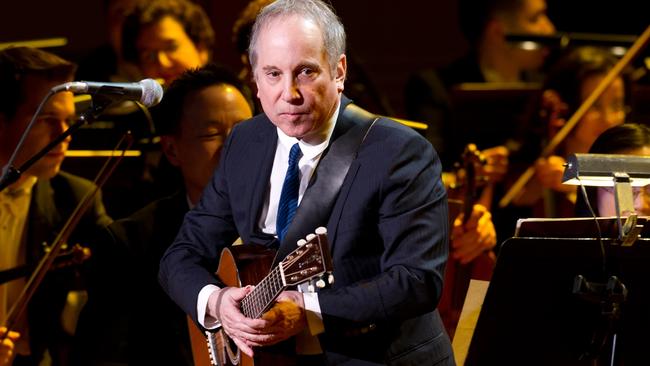The mystery and grace of songwriter and singer Paul Simon
Writing lyrics doesn’t just come naturally to Paul Simon, they arrive unexpected and uninvited, and at any time of the day.

Easter is here, and Passover is a few weeks away, so it’s a good time to look at the work of a great artist who’s brought considerable beauty into the world, Paul Simon.
Alex Gibney’s two-part documentary on the making of his most recent album is also beautiful – moving, mellow, sweet and deep. It tells of Simon’s life and touches on three big themes: the nature of creativity and where it comes from; that tricky thing called a career, which carries a talent out into the world and keeps it there, or not; and an ongoing spiritual event in Simon’s life that sounds like an ongoing miracle, or at least has pronounced supernatural aspects.
Simon, 82, is one of the greatest American songwriters, and you carry his songs in your head – Bridge Over Troubled Water, Scarborough Fair, American Tune, Mrs Robinson. It was classic after classic.
“People used to say, ‘Oh, you have your finger on the pulse,’ ” Simon says in the documentary. “And I would think, no, I don’t have my finger on the pulse, I just have my finger out there, and the pulse is running under it, for the time being.
“How long it lasts is a mystery, knowing the pulse is there and feeling its vibrations is a gift, putting your hand out there is the effort.”
He grew up in the New York City borough of Queens, where his heroes were Mickey Mantle, JFK, Lenny Bruce and Elvis. He met neighbourhood boy Art Garfunkel in sixth grade, and they began to sing together, Simon writing the music and Garfunkel harmonising.
“My culture was radio. It wasn’t like I was singing the music of Queens, you know? We didn’t have people sitting around on the porches in Queens singing fables about what it was like in Queens in the old days.”
What he worked with was AM radio Top 40 – the Everly Brothers, the Cleftones. America was becoming less local and regional even then, more a national entity projecting a national sound that generation after generation would imitate, recapitulate, expand on.

When Simon & Garfunkel first went on the American Bandstand TV show, Simon was asked where he was from. “Macon, Georgia,” he spontaneously lied. Because it sounded like a real place with a real meaning, not just someplace waves were passing through.
He took his guitar into the bathroom at his parents’ house to write. He felt a flow of creative energy and wondered what it was.
“One second ago that thought was not here and now I’m weeping. How’d that happen? And how can I do it again?”
Simon & Garfunkel knew huge recording success; would, in the coming decades, break up, reunite, part.
Popularity fluctuated. Simon’s career went hot and not-hot. There was a lukewarm period. Simon, solo, looking for the different sounds of the world, goes to Jamaica and South Africa. In the latter, in 1985, he is surrounded by singers and musicians and music he doesn’t know. They form the elements of what would become his masterpiece, Graceland. You hear the blunt, raucous accordion riff that opens The Boy in the Bubble, and it sounds so big.

Later, when Simon started writing the lyrics, he found his subject matter was unrelated to the world he’d just visited – he was writing about the Mississippi River, about Elvis Presley’s Graceland. Confused, he went there for the first time and realised he was writing about a father and son on a journey of repair. He accepted it, because creativity is a mystery.
“I really love the mystery.”
Once he told Dick Cavett he didn’t know why he wrote “Where have you gone, Joe DiMaggio? Our nation turns its lonely eyes to you” but he wasn’t perturbed not to understand. Some day it would mean something. It came to be a shorthand way of saying Americans have a sense of lessened greatness, that its heroes are in the past.

Now to the supernatural event. Simon and his wife, the musician Edie Brickell, had been living in Texas for a few years when, on January 15, 2019, he had a dream that said: “You’re working on a piece called Seven Psalms.” He hadn’t written anything in a few years, hadn’t wanted to, but the dream was so strong that he got up and wrote it down.
“I had no idea what that meant.”
Gradually, information came – chords, a sound. Then he started to wake up two or three times a week between 3.30am and 5am, and words would come.
“I’d write them down and if I tried to add to them – ‘Oh that’s a good verse, I’ll write a second verse’ – it would stop.”
He thought whatever it is, “it’s coming to me and that’s all, I just have to wait, and when it comes, write it down.”
He sings one of the songs that came of the process:
I’ve been thinking about the great migration
One by one they leave the flock
I’ve been wondering about their destination
Metal grass on a jagged rock
The Lord is my engineer
The Lord is the earth I ride on
The Lord is the face in the atmosphere
The path I slip and slide on
It’s beautiful. He alters the lyrics slightly on the final album, but they’re beautiful too.
Throughout all this, another major event. He suddenly lost hearing in his left ear. Within a month it was almost gone. He couldn’t hear his music the same, his voice sounded different; it used to come from here and now it was there.
He fell into depression, got out of bed, searched for remedies and workarounds. In time he thought maybe the whole thing – the dream, the words and sounds, the songs, the deafness – was part of the same whole, one he was meant to grapple with. Maybe it was supposed to be hard. Why not? The whole album was about an “argument” he is having with himself, which he later calls a “debate” “about belief or not”.
“Maybe it isn’t supposed to be so easy. Maybe you’re supposed to have an obstacle.”
Maybe the struggle helps you know what you know in a deeper way.
Trumpeter and composer Wynton Marsalis, another great artist and Simon’s close friend, told him, as he recorded, to “leave the struggle in there”.
He speaks of the psalms of David and makes biblical references – and once you see them you realise they’ve always been there in Simon’s work. All writers reveal their obsessions and preoccupations, and half the time they’re not even conscious of it. And no one knows where anyone’s going or what’s going on with them, but Simon is speaking the language of conversion, and I think he’s going to Graceland.
THE WALL STREET JOURNAL





